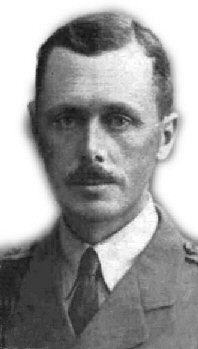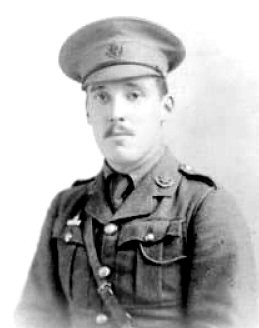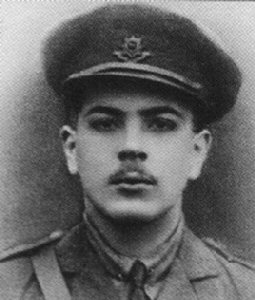7th Battalion Worcestershire Regiment - 1915
By the spring of 1915 the Territorial battalions of the 48th Division were fit in all respects to take the field, and on the last day of March (transport of the Battalion moved on the previous day, the 30th March 1915) the move to France began. The 1/7th Worcestershire bade farewell to their billets of the winter, entrained at Maldon East station and entrained for the front. The Battalion embarked at Folkestone on S.S. "Onward" after dark, reached Boulogne at midnight (31st March 1915) and then marched three miles to camp.
The officers who embarked with the Battalion were :— Lieut.-Colonel A. H. Harman, Major A. S. W. Dore, Captain and Adjt. G. M. C. Davidge, Lieutenants: A. G. Rollason, H. Adshead, T. C. F. Harris, H. Homfray, R. G. Addenbrooke, H. A. Leighton, Lieutenant and Quartermaster R. W. Nield. On the afternoon of the 1st April 1915 the Battalion entrained (3 p.m.) at Pont de Briques Station, meeting there the transport, which had been landed at Havre. The troop train carried the the Battalion to Cassel, where the South Midland Division was being concentrated. After detraining at Bavinchove Station at 3 a.m. on the 2nd April the Battalion marched to their allotted billets at Hardifort. Next day (April 3rd) the Brigade was inspected by General Sir Horace Smith Dorrien, commanding the Second Army. Then on April 5th the Division marched forward in soaking rain some twenty miles to billets by Bailleul. Five days of training and route marching followed, after which on April 10th the Territorial Battalions marched forward to the forward area near Armentières for practical instruction in trench warfare. The 1/7th Battalion was attached to the 18th Brigade. The Battalion was billetted at Armentières, and the Territorial platoons were attached in succession to companies of the battalions then holding the line. Platoon after platoon was initiated in the routine of trench warfare by the old soldiers who had endured the Winter months. Apart from sniping and bombing there was but little activity around Armentières, and the only casualty suffered during that probationary period occurred on April 14th, when 2/Lieut. R. K. Armstrong was wounded. |
Lieut.-Col. A. H. Harman |
Then the South Midland Division was entrusted with a definite section of the line, the front between the River Warnave and the Wulverghem-Messines road, covering Ploegsteert Wood. On the 17th April 1915 the 144th Brigade took over the right hand sector of the new Divisional line. The 1/7th Worcestershire went into the trenches for the first time as a complete unit, relieving the London Rifle Brigade.
On April 19th came the first fatal casualty, Private A. Boot being killed. On the same day Lance-Corporal J. R. Beagin of the Battalion signallers showed great gallantry while laying a telephone wire across exposed ground. He came under heavy fire and was severely wounded; but he pluckily completed the work. His gallantry was rewarded with the D.C.M. (this was the first ‘immediate award’ given in the 48th Division. Unfortunately the brave corporal later died of his wounds on the 2nd June 1915).
On the 21st April 1915 the 1/7th Battalion was relieved by the 1/8th Worcestershire Battalion and the 1/7th Battalion went into billets at Pont de Nieppe. The battalions changed over again a few days later on the 25th April with the 1/8th moving back to billets in Ploegsteert village.
Two days later orders were received for the Brigade to shift its position somewhat to the right. The shift was effected by moving the 1/7th Worcestershire from the left to the right of the Brigade front, and on April 30th the Battalion took over (from the 2nd Monmouthshire of the 4th Division) the trenches immediately south of the River Warnave (left flank of the Battalion on the line of the river. The 1/4th Gloucestershire, hitherto on the right of the Battalion, were now on the left flank). The 1/7th Worcestershire were relieved by its sister Battalion the 1/8th in those trenches on the last day of April 1915. Thenceforward for some two months the two Battalions held alternately that same line of trenches. When out of the line the two Battalions were billetted either in Brigade reserve at Ploegsteert or in Divisional reserve at Pont de Nieppe.
The total casualties of the Battalion up to the end of May were 11 men killed, 5 officers (2/Lt. R. K. Armstrong on the 14th April, Major A. S. W. Dore on the 6th May, 2/Lieut. D. B. Drake on the 19th May and Capt. F. G. Chamberlin on the 25th May) and 42 men wounded.
At the end of the month the command of the 48th Division was taken over by Major-General R. Fanshawe, C.B., D.S.O., afterwards Hon. Colonel of the 1/7th Battalion.
On June 15th a change in the Divisional dispositions resulted in the withdrawal of the whole 144th Brigade into Divisional Reserve. Both the 1/7th and 1/8th Battalions moved back into billets near Romarin. Four days later the Brigade moved to the left of the Divisional line, and took over the sector north of Ploegsteert Wood. The 1/7th Worcestershire relieved the 1/4th Royal Berkshire in the trenches between St. Yves and the River Douve, with the 1/8th Worcestershire behind them in reserve trenches. Nothing of note occurred during the next four days, and on June 23rd the two Battalions exchanged positions. That day came warning that the 48th Division was about to leave the Ploegsteert area. Their line would be taken over by the new 12th Division, and the 48th Division would move south to join the First Army.
On the night of the 24th/25th June, the very last night that the Territorial Battalions were to spend in the Ploegsteert trenches, occurred the sharpest fight they had yet seen.
On the 27th June 1915 , after a final inspection by Major-General Sir William Pulteney (commanding 3rd Corps.), the 144th Brigade marched to Vieux Berquin, the first stage on its route to the south.
The Brigades of the 48th Division marched southward independently on successive nights. On the evening of June 28th/29th the 144th Brigade marched to Robecq and on the following evening through Lillers to its destination in the IVth Corps area at Burbure.
There for a fortnight the 1/7th and 1/8th Worcestershire Battalions were in reserve resting and training. On July 11th orders came that the 48th Division would move up from reserve to relieve the 47th Division in the line about Grenay; and on the evening of July 12th the 144th Brigade moved forward from billets at Burbure to bivouac at Hesdigneul. Thence on the following night the Brigade marched through Noeux-les-Mines to Les Brebis. The 1/7th Worcestershire were detached from the Brigade and were sent on still further through Grenay to Maroc, an "unhealthy" spot, in which no lights or cooking were allowed.
The Territorial Battalions (1/7th and 1/8th) were now in that same unattractive mining area which the 2nd Battalion Worcestershire had known a month before, and for two days the battalions of the 144th Brigade were employed in constructing reserve lines of defence. Then came counter-orders.
Captain A. G. Rollason |
The expansion of the British forces in France had by that date warranted their sub-division into three separate "Armies", and it had been decided that the new Third Army should be formed in a part of the battle-front which as yet was unfamiliar to the British troops—the open country of Picardy about the River Somme. The 48th Division was to be one of the constituent units of the new Third Army and was ordered to move forthwith to the new area. As a result orders came for the 144th Brigade to return to Burbure as preliminary to the move south, and consequently on the night of 16th/17th July 1915 all four battalions of 144th Brigade marched back in their tracks to their former billets. The march was long and trying, along bad roads under heavy rain, but the 1/7th Worcestershire were able to record that in all the seventeen miles no man fell out. After two days in billets at Burbure the 1/7th and 1/8th Worcestershire marched to Lillers Station early on the 19th July 1915 and entrained to join the VIIth Corps in the area north of the River Somme. The railway journey of the two Territorial Battalions of the Regiment from the Flanders front came to an end late on July 19th. The two Battalions detrained (7th Battalion 4 p.m., 8th Battalion 8.30 p.m.) at Mondicourt and marched to billets near Authie. On the following day (July 20th) both Battalions moved forward and went into bivouac in the Bois de Warnimont (That period in the Bois de Warnimont was most uncomfortable, under very heavy rain, from which the troops had no shelter except such as they could construct from the brushwood. Many were invalided, and Captain A. G. Rollason died on July 30th from the effects of the exposure and appendicitis). There the 144th Brigade lay in Divisional Reserve for a week, while the other two brigades of their Division took over the front line (from the French 21st Division). Then on July 30th the 144th Brigade moved forward in its turn and all four of its battalions went into the line; each battalion being disposed in depth. The 1/7th and 1/8th Worcestershire were now lying side by side, together holding the left half of the Brigade front. |
Thus they remained until the 7th August 1915 when the 144th Brigade was relieved and moved back into Reserve, the 1/7th Battalion being billeted in St. Leger and the 1/8th Battalion in Bayencourt. In that area, varied by shifts to billets in the neighbouring villages of Courcelles, Souastre and Bus the two Battalions remained throughout the Autumn.
At first the trenches at Hebuterne were very quiet, the opposing lines were far apart and, save for some desultory shelling there was little to cause loss. Casualties were slight.
Casualties;
August 1st to 31st 1915 - 2/Lt. M. B. S. Spencer and 2 privates killed, 2 wounded.
September 1st to 30th 1915 - 3 wounded.
In the Third Army area the Loos offensive had but little affected the routine of the 48th Division. The British artillery there as elsewhere had heavily bombarded the enemy's trenches; but the 144th Brigade, then in Divisional Reserve, did little on the day of the great attack (25th September). The Brigade waited in their billets at Bus and Souastre throughout a rainy day for an order to advance which was expected but which did not materialize. Afterwards the troops in the Somme area settled down again to trench warfare. The Hebuterne sector, "quiet" during the summer became "quieter" still during the winter, as driving rain and bitter frost undermined and crumbled the clay sides of the trenches. All ranks had to work their hardest to maintain the defences, and it became impracticable to attempt any serious offensive action against the enemy: who themselves were in little better plight. The enemy's trenches were originally somewhat more comfortable, being a strong support line to which they had been driven back by the French before the British took over the line; but they were on the down slope, and it was possible to drain water from the British trenches towards their line. Apart from that incessant labour, few events of importance occurred to the 1/7th Battalion in the interval between Loos and the New Year. (On 7th November 1915, Captain G. S. Tomkinson, then acting as Brigade Bombing Officer, was wounded by a rifle-grenade. On 23rd December 1915, Lieut. R. A. Leighton, 1/7th Battalion was mortally wounded. |
Lieut. R. A. Leighton |



